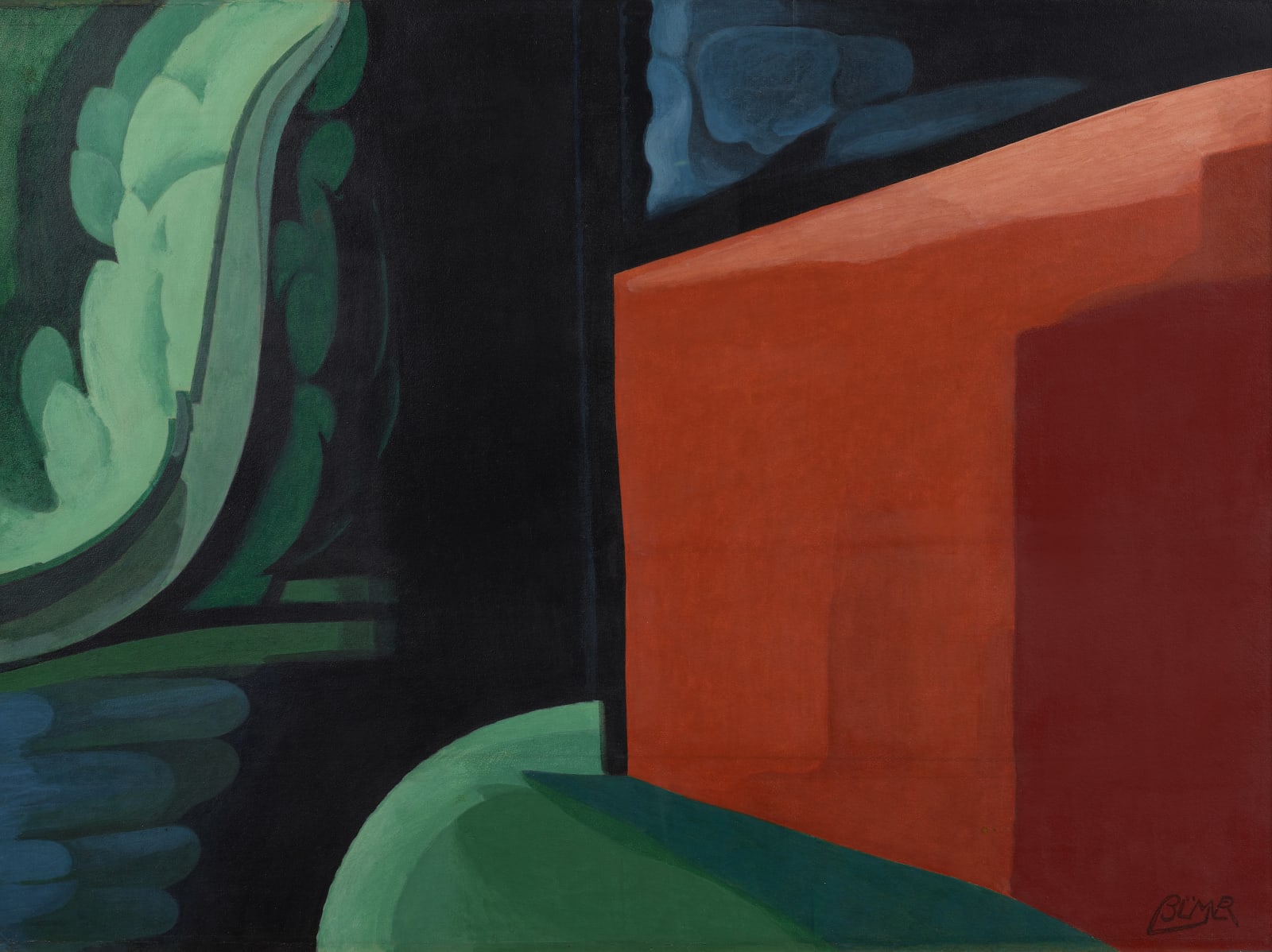Oscar Bluemner German, American, 1867-1938
59.4 x 80 cm
Bluemner’s diary entry for Approaching Black records the location as “end of a path” on the Bloomfield Canal and the idea as the “simplest setting of simplest forms of our surroundings in dramatic tension.” Approaching Black exemplifies Bluemner’s mature caseins and was among a large group that were shown in the last solo show held during his lifetime, a 1935 exhibition at the Marie Harriman Gallery called Compositions for Color Themes. Despite favorable reviews for his previous “Sun and Moon” pictures of the late 1920s, the exhibition resulted in disappointing sales. Yet in the years that followed he embarked on an ambitious series of paintings that paired even stronger color and deeper emotion. The late Harriman pictures stand out through Bluemner’s use of color to represent musical tones as he attempted to create the sensation of listening to music. He asked his audience to “Look at my work [as you would] listen to music,” referencing his favorite composers such as Bach, Beethoven and Liszt, to name a few. These works are based on sketches of ordinary structures in the familiar factory landscape and reveal greater symbolism with buildings representing the male presence and trees standing for the female role. Critic Margaret Bruening’s review calls to mind Approaching Black: “an orchestration of brilliant colors, usually played in the upper reaches of the scale with big crashing chords of black to sustain the theme.”
Provenance
The artist; to
Estate of the artist; to
Vera Bluemner Kouba (the artist’s daughter);
Elton and Penny Yasuna;
Southwestern Bell Corporation, St. Louis, Missouri;
[Richard York Gallery, New York]; to
Private collection, New Jersey;
[Barbara Mathes Gallery, New York, 2006]; to
Karen and Kevin Kennedy Collection
Exhibitions
Marie Harriman Gallery, New York, New Landscape Painting by Oscar F. Bluemner: Compositions for Color Themes, January 2–26, 1935, no. 21 // University Gallery, University of Minnesota, Minneapolis, Oscar Florianus Bluemner, March 2–28, 1939, no. 10 // Corcoran Gallery of Art, Washington, D.C.; Amon Carter Museum, Fort Worth, Texas; and New Jersey State Museum, Trenton, Oscar Bluemner: Landscapes of Sorrow and Joy, December 10, 1988–September 3, 1989, no. 104 // Barbara Mathes Gallery, New York, Bluemner on Paper, October 27, 2005–January 28, 2006, no. 27 // Denver Art Museum; and Burchfield Penney Art Center, Buffalo, New York, What It Meant to Be Modern, 1910–1965: American Works on Paper from the Karen and Kevin Kennedy Collection, August 21, 2016–June 23, 2017 // Menconi + Schoelkopf, New York, Bluemner and the Critics, November 9–December 17, 2021, no. 25
Literature
Oscar Bluemner papers, 1886–1939, Archives of American Art, Smithsonian Institution // Margaret Breuning, “Paintings by Bluemner at Harriman Gallery,” New York Post, January 12, 1935 // Jeffrey R. Hayes, Oscar Bluemner: Landscapes of Sorrow and Joy, Washington, D.C.: Corcoran Gallery of Art, 1988, no. 104, illus. // Jeffrey R. Hayes, Oscar Bluemner, New York: Cambridge University Press, 1991, p. 153, nos. 102, 117, illus. // Laura Carey Martin, ed., American Images: The SBC Collection of Twentieth-Century American Art, New York: SBC Communications, 1996, pp. 89, 283, no. 32 // Jeffrey R. Hayes, Bluemner on Paper, New York: Barbara Mathes Gallery, 2005, pp. 12–13, no. 27, illus. // Barbara Haskell, The Image of Modernism: Selections from the Karen and Kevin Kennedy Collection, G.ttingen: Steidl, 2008, illus. // Nanette V. Maciejunes, What It Meant to Be Modern, 1910–1965: American Works on Paper from the Karen and Kevin Kennedy Collection, Colorado: Denver Art Museum, 2016, pp. 13, 31, illus. // Roberta Smith Favis, Bluemner and the Critics, New York: Menconi + Schoelkopf, 2021, p. 75, no. 25, illus. pp. 64–65

